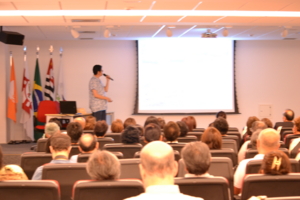"Connecting" buckwheat flour and water and "connecting" ourselves for reconstruction
みなさん、こんにちは!
いつものことながらyuiです。
Federicaさんの記事によると、イタリアは日本同様、とっても寒かったようですね!!
今日はそんな寒い冬とは正反対にあるブラジルはサンパウロでの事業の紹介をしたいと思います!
Hi! This is yui as always.
According to Federica, it seems that Italy had a tough winter this year!
Today, I will introduce an event in Sao Paulo in summer!
ご紹介するのは、日本食に関するレクチャーとデモンストレーションです。
今回はちょうど震災から一年が経過した3月ということで、東北地方の復興を祈り
仙台でそば屋さんを営む森浩一シェフをお招きして開催しました。
森浩一シェフ Chef Koichi Mori
場所はSENAC(セナキ)というブラジル国立の職業訓練専門学校のうち、料理を教えているSENAC Aclimacao(アクリマソン)にて実施しました。
リフォームされたばかりらしく、建物はとってもきれいで設備もとても整っています!
The event is a lecture and demonstration of Japanese cuisine.
As 1 year has passed since the Great East Japan Earthquake, the Japan Foundation, Sao Paulo presented this event hoping the reconstruction of Tohoku region by inviting Mr. Koichi Mori who is a chef of a Soba restaurant in Sendai, Miyagi.
The venue was SENAC Aclimacao, which is a national job-training school specialized in cooking.
As the building has been just reformed, it is very nice and clean, and also well equipped!
まずは、そば打ちのデモンストレーションを見る前に、日本食についての基本的な説明をサンパウロ在住の豊田ルミ先生にしていただきました。
Before the demonstration of Soba-uchi (Soba making process), Ms. Lumi Toyoda gave us a brief lecture on Japanese cuisine and manner.
和食の背景となる日本の風土や季節のことや、お箸の使い方などをご説明いただきました。
会場に集まってくださった70人ほどの来場者のみなさんは、メモをとりながら真剣に先生のお話に耳を傾けていました。
She explained Japanese climate and seasons behind Japanese cuisine as well as how to use chopsticks.
Everyone in the hall was so earnest and some of them were taking notes.
お箸の使い方を習ったところで、いよいよお待ちかねのそば打ちのデモンストレーションです!
デモンストレーションでは粉に水を混ぜるところから、のして切るところまで一連の流れを見せていただきました。
来場者のみなさんが感心していたのは「のし」の作業。
After the lecture, it was the time for demonstration!
The demonstration covered all the process from mixing Soba-ko (buckwheat flour) and water to cutting them into noodles.
The most impressive process was rolling out soba dough.
最初は丸くのしていきますが、「角出し(つのだし)」という作業で四角に形が変わっていく様子はまさに手品のよう。
みなさんを「おぉ~」と驚いていました。
He rolled out the soba dough into a circle shape at first, and then making it into square in the process called "Tsuno-dashi"(making corners).
Everyone was surprised and admired that he rolled out the dough so accurately and quickly.
そしてやっぱり切る作業ですよね。
カメラやビデオで撮影をしている人もたくさんいらっしゃいましたが、このときばかりはみなさん立って身を乗り出してご覧になっていました!
すばやく、かつ均等に切っていく様子に感心しきりの様子でした。
Another highlight of the demonstration was cutting process.
Some of audiences were taking photos and videos, and others leaned over and look into chef's hands!
Accuracy and speed were remarkable at this time, too.
最後は、そばの試食タイム。
みなさん、お箸を使ってそばをいただきます。この日のおそばは抹茶がはいった変わりそば。
みなさんおいしそうに召し上がっていました!
In the end of the demonstration, we had a tasting time, which everyone was waiting for!
Today's soba was "Kawari-soba" in which maccha (green tea powder) was mixed. Everyone looked happy eating soba with chopsticks!
最近ヘルシー志向の人が増えているブラジルでは和食は注目されているそうですが、すし、てんぷら以外の料理はまだあまり知られていないそうです。
日系社会があるブラジルで?とちょっと意外なような気もしますが、和食普及はまだまだこれからなんですね!
In Brazil, people are getting more aware of healthy food including Japanese cuisine recently, but sushi and tempura are the only famous foods.
The fact is a little different from our image of Brazil, where it has many Japanese-Brazilians.
Yet it means there is still much possibility to get more Japanese-food lovers!







No comments:
Post a Comment